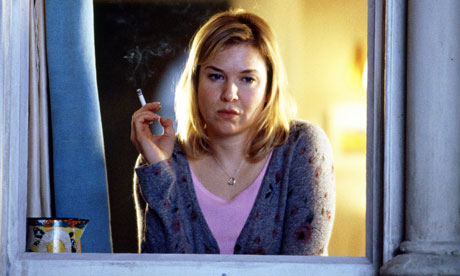
Bridget Jones and the army of weight-obsessed young heroines who followed in her footsteps have a lot to answer for, according to academics, who have found that women's body image is negatively affected by chick lit.
New research from Virginia Tech, published in the journal Body Image, analysed "the effect of protagonist body weight and body esteem on female readers' body esteem", and concluded that "scholars and health officials should be concerned about the effect chick lit novels might have on women's body image". Co-author Melissa Kaminski, a chick lit fan, said she was prompted to launch the study after noticing that "body image research frequently looked at how visual images of thin women negatively affected women's body esteem, [but] no research had examined how textual representations of body esteem and body weight affected female readers' body esteem".
Researchers chose two chick lit novels – Emily Giffin's Something Borrowed, and Laura Jensen Walker's Dreaming in Black and White, each of which features heroines with "healthy body weight" but "low body esteem". They adapted a passage from each of them to come up with nine versions for each novel, from an underweight heroine with high body esteem to an overweight one with low body esteem, so there might be a character who states: "I'm 5'4", 140lb, and a size six", or one who says: "I'm 5'4", 105lb, and a size zero".
They then distributed the passages amongst 159 female university students, who after reading them were then asked to rate how they felt about various body parts and sexual attractiveness. The study found that when the narrative was about a slim heroine, participants felt "significantly" less sexually attractive, and that when it featured a protagonist with low body esteem, readers were "significantly more concerned about their weight" than participants in the control condition.
"The negative effects produced from the current study underscore the concern of previous scholars for the potential effect of chick lit protagonists' obsession with weight and appearance," write Kaminski and co-author Robert Magee in the study, "Does this book make me look fat?". "Scholars and health officials should be concerned about the effect novels have on women's body image, especially since these issues could lead to disordered eating and other health issues."
The academics suggest that a future study could look at using chick-lit narratives as an "intervention tool" to fight poor body esteem in teenage females, with the creation of stories in which characters with low body esteem seek support from family and friends.
"I think the findings of my research should be used to raise awareness," said Kaminski. "Some preliminary findings from one of my unpublished studies indicate that if readers are aware that they identify with a character with poor body esteem, the readers actively work against the negative effects and report more satisfaction with their bodies. So, by possibly letting readers know that protagonists with poor body esteem may harm their own body esteem, it may help readers fight against these negative effects. I plan on pursuing this further in the future."
Bestselling romantic novelist Katie Fforde called the research "slightly concerning". "When I used to read an awful lot of Mills & Boon novels, I was worried that I couldn't become these terribly beautiful people, and that I wasn't going to have a romance like them. So when I wrote my first novel, I made my heroine have mascara under her eyes, and be slightly overweight, lying down to get her jeans on. I wanted to write it for people who don't have perfect figures, to show that sometimes lovely things can happen to people who aren't perfect-looking," she said. "It would worry me to think [my characters] might worry people … but I don't think I could change a book because someone was having doubts. I'm currently writing about an older heroine attracted to a younger man, and she has all sorts of doubts and fears - I couldn't take those away … I think authors should just write the best book they can."

